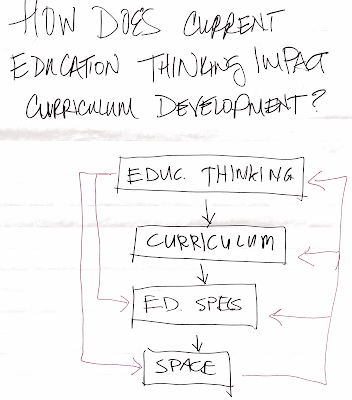The future of schools was the topic of AIA's Education Committee convening at the new Westowne Elementary School in Catonsville.
The brandnew school looks quite familiar (and I don't mean because it has an almost identical twin in Owings Mills in the Lyons Mill ES there): hallways of painted concrete block, steel lockers, cafeteria and gym side by side and somewhat interchangeable, an intercom blaring instructions to the little students when to line up for their buses. "Melbrook bus riders please prepare for dismissal"
"Ingleside bus riders this is your last call".
 |
| Westowne ES, Catonsville |
On second glance and with the help of tour guide from GWOO architects innovations came into focus: Soft seating sofas, beanbags, wiggle balls to sit on, neighborhoods ordered according to age groups and "pods". There is a roofdeck for outdoor activities and a green roof as well. Daylight and brightness are clearly emphasized.
In the panel discussion experts from the State Department of Education, the County School system, the school and from Towson State were on hand to discuss the relationships between pedagogies, curriculum, technology and space. Issues, opinions and predictions galore. In today's eduction world even an elementary school has a vision and a mission.
Westowne Elementary Vision
Westowne Elementary School envisions a safe, nurturing, and personalized learning environment that is student-centered, collaborative, and enhanced by digital resources which engages and empowers all students to become lifelong learners and achieve within a globally competitive society.
Westowne Elementary Mission
Westowne Elementary School is committed to educating the whole child, while providing a safe and nurturing environment that promotes a passion for lifelong learning, respect for self, others, the learning environment and an appreciation for individual differences.
In County schools each student will get one of those touch screen tablets. Will technology take over? Will it enable the students to work according to her own pace, style and methods or will those devices force students that don't do well with them into something that doesn't help them to learn? Will the tablet be the Trojan horse of private learning industry in the classroom allowing them to glean tons of data to assess not only the student but her family? Professor Morna McDermott of Towson University was very vocal in her concern that schools will slip from the public sector into privatization in the name of cost saving and societal needs. Academic brokers often online entrepreneurs could take over. She explained how the industrial style assembly line school is being replaced by the service industry style school with its openness, collaboration and interdisciplinary mingling. But she is concerned that the next step will be the end of the public school.
 |
| Media Center and library |
Jim Determan of HCM Architects mentioned the famous mantra of learning center environments instead of teacher centered ones and the four C's of 21st century learning: critical thinking, communication, collaboration, and creativity.
Plenty of terms flew around the room: "The Every Students Succeeds Act (ESSA)", digital conversion, learner centered classroom, universal design of learning, project-based learning, compentency based teaching and the teacher as a facilitator. It sounded as if all those elementary kids would have to enter a college tomorrow and a job the day after.
For my own taste, the issue of "developmental appropriateness" mentioned by McDermott once in passing got short thrift. From my experience in designing schools in Germany, learning from my own children and grandchildren and influence from a cousin who is an architect for Waldorf Schools overseas, from that perspective one would begin the entire pedagogy and space question with the emotional needs and well being of the child.
If one did this, concrete block walls and steel lockers, teachers talking over a microphone to their students in the classroom so they sound like robots and spaces that are so flexible that everything is on wheels would be out of the question just as much as those airport style stress inducing bus boarding instructions. At least for elementary school students, especially in a time where the family and unstructured activity have become an ever smaller part in the day of a child. But as
 |
| Concrete block, steel lockers in long hallways |
Westowne wound up with an extreme example of this desire to build flexible shells that can be Elementary Schools today and a Middle School tomorrow. According to Principal Scott Palmer, the new school wound up with expensively furnished science rooms that are not usable for small children who experiment with cardboard and play dough. The science rooms are equipped with real science tables, storage for chemicals and exhaust hoods. They will be changed in favor of what schools now call "Maker Spaces". Schools certainly pick up on fashionable language.
Raising a child, though, should follow far less ephemeral values and those, reflected in architecture, are supposed to stand the test in time.
I left encouraged that schools are trying to adjust to new realities but not sure that current trends don't loose sight of the forest for all the trees.
Klaus Philipsen, FAIA
Correction: The name of the school Principal is John Palmer. Mike Archbald is a member of the Design Office of Engineering and Construction at Baltimore County Public Schools. He moderated the discussion.
 |
| Classroom: teacher speaks through a mike |
 |
| color tiles as "neighborhood" identifiers |
 |
| soft seating: Popular hangouts in the pod |
 |
| Neighborhood pod |
 |
| Big gym for small people |
 |
| The cafeteria looks like the gym: Huge for a six year old |
 |
| group notes |
 |
| hallway art as an attempt of taking possession of the space |
 |
| Group notes |


No comments:
Post a Comment